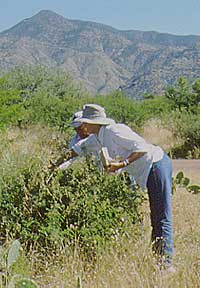Suzanne Nelson is director of conservation and seed bank curator at Native Seeds/SEARCH in Tucson, Ariz.
Monday, 9 Aug 1999
TUCSON, Ariz.
Monday, Monday, can’t trust that day … I never know exactly what’s in store for me when I get into the office on Monday. I used to think it was a good day to consider the week ahead and plan for what needed to be accomplished. More and more, I find Mondays to be good days to put out fires, mostly fires that have been smoldering since days and weeks gone by.
Today, I’m behind on an article for the next issue of the “Seedhead News,” the Native Seeds/SEARCH newsletter. It’s due tomorrow and I’ve barely started — though I have at least begun! Perhaps it’s karma that I should be needing to get that done on the first day of my week as diarist, since the article is about the project that brought NS/S into the Grist periscope in the first place.

Red hot chile peppers.
The project I’m referring to is what NS/S staff have always called the “Chile Reserve.” It began, rather inauspiciously, about 10 years ago when an observant native plant enthusiast noticed the existence of a few populations of wild chiles (Capsicum annuum var. aviculare) in southern Arizona. It would only have meant much to anyone who knew plant geography — wild chiles occur primarily in more tropical climes between Mexico and South America. That there were a few small populations on this side of the U.S.-Mexico border, in particular, where frosts regularly occur, was of great interest to a few select plant people.
As is customary of plant people, the first thing they wanted to know was how many wild chiles were growing in the U.S. And where else did they grow? Systematic hunting revealed that wild chiles occur in several canyons in southern Arizona and in southern Texas as well. In neither case, however, do they reach very far north of the frontera. Researchers were also interested in the distribution of these plants in adjacent Sonora, Mexico, where they are commonplace in every kitchen and restaurant south of the border. (Of course, in Mexico, wild chiles completely circumvent the question of spelling that plagues us gringos — “chile” versus “chili” — by using the less controversial “chiltepin” [pronounced chill-tuh-peen].) Not to anyone’s great surprise, chiltepines were found to be nearly ubiquitous along the foothills of the Sierra Madre Occidental in Sonora. None of these are small, isolated, remnant, or disjunct populations. This is chiltepin country. Brave and bold.
Interest in the chiltepines on this side of the border grew, as did the realization that they represented a potential gene pool not likely found in more southerly populations. The question now was, How could these unique resources be protected? One of the populations of wild chiles occurred on Coronado National Forest land. Public land. Seems obvious, doesn’t it? It did to a few of our staff members at the time too, who entered into a five-year memorandum of understanding (MOU) with the Coronado National Forest, allowing Native Seeds/SEARCH to conduct research on the site and help draft management guidelines focused on the chiltepines. Under the MOU, the flora and fauna were surveyed — 14 rare, threatened, endangered, or otherwise unique plant species were identified on the site, including such crop relatives as wild grape, cotton, and bean.

Nelson, pickin’.
Over the years, research efforts at the “Chile Reserve” have included interviewing local residents with a history of collecting chiltepines for use in their homes; determining what the area is used for (e.g., hunting, birding) and by whom; individually tagging and mapping chiltepines; constructing small fenced exclosures so we can examine the effects of grazing; evaluating the effects of fire management and wood collecting; sampling existing vegetation for diversity and abundance; producing a GIS database for the area; studying the feeding preferences of birds and mammals; and determining who consumes and disperses chiltepin seed.
And to what end all the work and interest in this small population of chiltepines growing in gringo-land? As of June 3, 1999, the 2,500-acre “Chile Reserve” was officially designated a “Wild Chile Botanical Area” within the Coronado National Forest. This designation confers a recognition of the unique genetic resources of the land and establishes a process for developing sustainable management guidelines by government, private, and non-profit interests.
(Hot to learn more about these chiles? Read a story by Amy Nevala on the Wild Chile Botanical Area.)

